Church of St Gregory, Bedale
The Church of St Gregory, Bedale is the parish church for the town of Bedale in North Yorkshire, England. It is the main church of the benefice of Bedale and Leeming and Thornton Watlass. A stone church in Bedale was mentioned in the Domesday Book, but the present structure dates back to the latter part of the 12th century, with further restorations over the last 800 years. The grade I listed building has many notable features including a medieval image of a left handed St George fighting a dragon and the tower, set to the western side, which was built with a portcullis in a defensive capacity.
| Church of St Gregory, Bedale | |
|---|---|
| St Gregory's Church | |
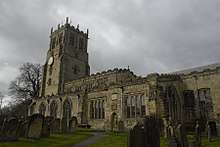 The Church of St Gregory in Bedale | |
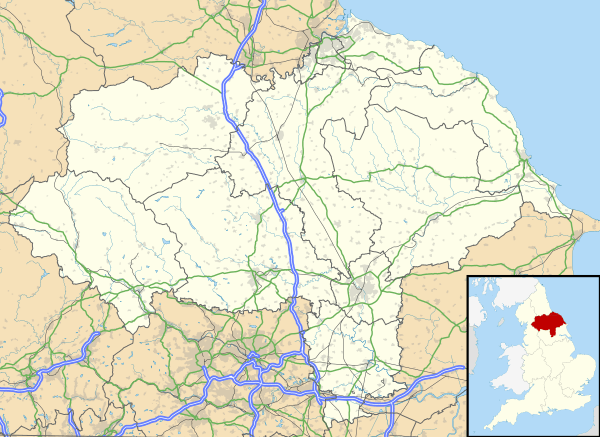 Church of St Gregory, Bedale Location within North Yorkshire | |
| OS grid reference | SE265884 |
| Location | Bedale, North Yorkshire |
| Country | England |
| Denomination | Church of England |
| Weekly attendance | 80–100 (average)[1][note 1] |
| Website | Official website |
| History | |
| Status | Active |
| Dedication | Pope Gregory I[2] |
| Architecture | |
| Architectural type | Early English Decorated Perpendicular |
| Specifications | |
| Length | 120 feet (37 m) (west to east) |
| Width | 61 feet (19 m) (north to south) |
| Spire height | 98 feet (30 m) |
| Administration | |
| Parish | Bedale |
| Deanery | Wensley |
| Archdeaconry | Richmond & Craven |
| Diocese | Leeds |
| Clergy | |
| Vicar(s) | Simon Moor |
Listed Building – Grade I | |
| Designated | 22 August 1966 |
| Reference no. | 1151205 |
The church is located at what is known as the 'Top of the Town' which is at the northern end of the high street. The churchyard is set with yew trees and falls away to Bedale Beck to the east.[3] The church features in the book England's Thousand Best Churches by Simon Jenkins.
History
The Domesday Book stated in 1086, that a place of worship existed on the site of where the present church is, which would suggest that the church appears to have escaped the Harrying of the North.[4] McCall stated that the architecture of the previous Anglo-Saxon church (some of which is incorporated into the present building), points to the previous church being constructed in 850.[5] Pre-Norman Conquest stones were found in the crypt of the church, which were detailed with serpents biting their own tails and the image of a serpent with the head of a human taking part in The Temptation.[6] The crypt is underneath the chancel and retains two of the six Anglo-Saxon stones found there in the 19th century. The crypt is believed to have acted as a sacristy at some point before it was turned into a mausoleum.[7] The crypt still retains a stone altar and access is by an external door at the east end of the church, the access directly adjacent the altar in the chancel has been boarded over.[8]
Whilst the present church dates back to the 13th century, additions and restorations were carried out in the 14th, 15th and 19th centuries.[9] The nave and north aisle date to the 12th/13th century whereas the south aisle and south chapel were constructed around 1290.[10] As with many churches of its time, additions and extensions were added at different dates; in the late 12th century the chancel was extended southwards into the south chapel (later the Lady Chapel), with the south aisle and chapel being rebuilt in 1290. As such, the church displays three different types of architecture; Decorated, Early English and Perpendicular.[11] Detailed structural analysis estimates that the original Anglo-Saxon church on the site has been suggested to have been 48 feet (15 m) long, 24 feet (7.3 m) wide and 24 feet (7.3 m) tall.[12] The present church is 120 feet (37 m) long, 61 feet (19 m) wide, with the tower height being 98 feet (30 m) high.[13] It is dedicated to Saint Gregory, but the date of dedication is unknown. It was known as the Church of St Gregory when Brian de Thornhill was rector in the 14th century, but the earliest written confirmation occurs in 1547 when it is specifically mentioned in a will.[14]
The north doorway was blocked up in the 14th century with the accompanying north aisle showing three piers with differing styles; octagonal, quatrefoil and cruciform.[15] The south doorway is also blocked up and has had a sundial affixed on the outside dated 1556.[16]
The 98-foot (30 m) high tower,[17] recognised as being rare in this part of Northern England (due to its portcullis), dates from the 1330s and was built as a defensive structure.[18] To protect the townsfolk from marauding forces, a portcullis was installed at the foot of the tower, and whilst the grooves showing where it would be used are still extant, it was largely forgotten about until it came crashing down in the 19th century due to corrosion.[16][note 2][19] The middle floor of the tower contains a fireplace and other domestic features (bedrooms etc) so it is believed to be part of Bedale Castle which is said to have existed immediately to the west of the church.[note 3][20] The uppermost floor of the tower is Perpendicular in nature and is finished with eight pinnacles.[11] Other similar fortified towers were built at churches in Melsonby, Spennithorne and Thornton Watlass at around the same time in history.[21] The clock on the tower was a gift from the Beresford-Peirse family in 1873.[22]
The tower was long believed to have been built by Bryan FitzAlan, but Clement Hodges, writing in The Early History of Bedale states that the architectural style belies this fact as FitzAlan died in 1306, well before the start of Ogival architecture in the 1320s. Clement Hodges states that it was more likely his wife, Mathilda,[23] who completed the tower in the 1330s and who lived until 1340.[24] Much of the building of the church is attributed to Thomas FitzAlan, the son of Bryan, who was a rector at the church in the lat 12th century.[16]
Several wall paintings were uncovered during restoration work in the 1920s.[17] These include The Creed and The Lord's Prayer above the nave and a depiction of St George fighting a dragon in St George's Chapel. The paintings are thought to be over 500 years old and the one of St George has been notified as quite rare as it shows St George being left handed as he is fighting the dragon.[25] It is thought that these images were covered over with whitewash during The Reformation.[2]
The church contains one of the oldest ringable bells in the England; it weighs 26 long cwt (2,900 lb or 1,300 kg) and was installed in 1360. The bell is commonly known as The Jervaulx Bell, as it was brought to the church from Jervaulx Abbey in the middle of the 14th century.[26] The other eight bells in the belfry are from the 17th, 18th and 19th centuries,[27] with the Sanctus bell being cast in 1753.[8]
The east window of the Lady Chapel (the south aisle) is believed to have been transported to St Gregory's from Jervaulx Abbey after the dissolution.[28][29] Pevsner states his disappointment that all the other windows in the church are Victorian in origin, but notes that the East window is a William Wailes creation.[15] The Clerestory was added in 1400 and allows light into the church through its four windows on either side of the aisle.[30]
St Gregory's is the main church in the benefice of Bedale and Leeming and Thornton Watlass. The benefice was created in 2007 when a lack of clergy prompted a parish merger.[31] Stainless steel roofing was installed in 2016 after lead was stolen from the church roof. Special dispensation had to be awarded by Historic England for the substitution of metals to go ahead and a grant was awarded from the Listed Places of Worship Roof Repair Fund.[32] Simon Jenkins mentions the church in his book England's Thousand Best Churches, describing St Gregory's as being
...a strong church in every sense [with] a fine crypt and magnificent headstones[33]
Effigies and monuments
The tomb of Bryan FitzAlan and his first wife used to be on the south side of the church. This tomb was destroyed at an unknown date and the two effigies of FitzAlan and his wife now rest at the north-western end of the church.[16] An effigy of Brian de Thornhill, the third rector in charge at Gregory's from 1298 lies in the north chapel against the north wall.[34] Glynne noted two more effigies of knights located in the tower[35][36] and in the aisle of the north chapel, set into the stone floor, is a brass effigy to Thomas Jackson. This includes a Latin inscription and whilst it is faded now, Dodsworth writing in 1622 recorded it as Hic jacet Thomas Jackson quondam mercator de Bedall qui obiit primo die mensis julii anno dñi mccccc xxix. Cujus anime propitietur deus, amen.[34]
The 18th century conjurer, quack and scientific lecturer Gustavus Katterfelto is buried near the altar in the church.[37]
Listed structures
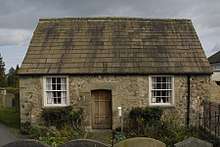
Besides the church itself, which is grade I listed,[38] there are a further three structures within the churchyard that are listed with Historic England;
- The Old Grammar School - grade II listed - now acts as the parish office[39]
- The churchyard gates - grade II listed - are at the south entrance that faces down towards the High Street[40]
- The War Memorial - grade II listed - erected in 1920, the memorial now commemorates both the dead from the First and Second World Wars[41][42]
The vicarage, immediately to the north of the churchyard is listed at grade II status.[43]
Clergy
The following is a list of vicars who have served at St Gregory's. Transcription from the parish register has thrown up many different spellings (Dowsen/Dowson), these as are as given in "The Early History of Bedale" by Clement-Hodges and McCall.[44]
| Year | Incumbent | Year | Incumbent | Year | Incumbent | Year | Incumbent | |||
|---|---|---|---|---|---|---|---|---|---|---|
| 1198 | Elias | 1480 | George Fitzhugh | 1657 | John Gunter | 1899 | Windham de la Poer Beresford Peirse | |||
| 1254 | Thomas son of Brian (FitzAlan) | 1495 | Thomas Magnus | 1660 | Peter Samwaies | 1931 | Arthur Rupert Browne Wilkinson | |||
| 1295 | Walter de Langton | 1550 | Henry Ilkens | 1698 | Francis Pemberton | 1938 | Harold Victor Hodson | |||
| 1298 | Brian de Thornhill | 1569 | John Tyms | 1721 | Robert Lumley | 1951 | John Massingberd Mundy | |||
| 1355 | Laurence de Thornhill | 1593 | Robert Beverly | 1731 | Edward Place | 1965 | Frank William Armitage Ledgard | |||
| 1369 | John de Hermesthorp | 1618 | John Pettie | 1775 | Henry Dawnay | 1988 | Malcolm David Emmel | |||
| 1415 | William Grey | 1621 | John Wilson | 1783 | Richard Clark | 1998 | David Graham Paton-Williams | |||
| 1426 | Robert Morton | 1634 | Henry Wickham | 1797 | Thomas Monson | 2010 | Simon Paul Ruckin | |||
| 1450 | Richard Alfreton | 1641 | William Metcalfe | 1843 | John Joseph Thomas Monson | 2012 | Ian Morgan Robinson[45] | |||
| 1464 | Robert Fleming | 1653 | Ralph Dowson | 1861 | John George Beresford | 2019 | Simon Moor |
After an interregnum, the Reverend Simon Moor became the vicar of the Benefice at Bedale in June 2019.[46]
Gallery
 Interior door to the tower. The space between the two arches used to hold a portcullis for defensive purposes
Interior door to the tower. The space between the two arches used to hold a portcullis for defensive purposes The font
The font St George and the dragon
St George and the dragon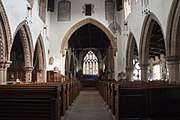 Interior view looking easte
Interior view looking easte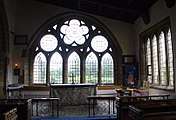 Stained Glass in the Lady Chapel
Stained Glass in the Lady Chapel
Notes
- Data is taken from that surveyed between 2006 and 2015
- Clement Hodges notes that the portcullis was said to have come crashing down due to a lightning strike and that it had to be hacked away and was then sold for scrap metal.
- The castle is surmised to have existed as some historians and writers have alluded to its presence with the foundations being underneath the grounds of Bedale Hall. Some have argued that the castle did not exist and that the building was a hunting lodge.
References
- "Dashboard for the parish of Bedale in the Deanery of WENSLEY" (PDF). leeds.anglican.org. September 2015. p. 1. Retrieved 8 June 2018.
- "How the church bells rang out to sound the Conqueror's curfews". The Northern Echo. 14 November 2003. Retrieved 26 May 2018.
- BCAA 2010, p. 17.
- BCAA 2010, p. 7.
- Reynolds 2001, p. 2.
- Clement Hodges 1907, p. 77.
- Clement Hodges 1907, pp. 44–45.
- "St Gregorys Bedale | Background". www.bedale.church. Retrieved 10 June 2018.
- BCAA 2010, p. 11.
- Historic England. "Church of St Gregory (52197)". PastScape. Retrieved 24 May 2018.
- Glynne 2007, p. 86.
- Clement Hodges 1907, p. 76.
- Doubleday 1968, p. 297.
- Clement Hodges 1907, pp. 101–102.
- Pevsner 1973, p. 75.
- "Genuki: BEDALE: Geographical and Historical information from the year 1890., Yorkshire (North Riding)". www.genuki.org.uk. Retrieved 27 May 2018.
- Foster, Mark (13 March 2000). "Appeal for funds to restore church". The Northern Echo. ProQuest 328926001.
- Gleeson, Janet (10 July 2017). "Major changes planned for ancient church". York Press. Retrieved 24 May 2018.
- Clement Hodges 1907, p. 93.
- Moule, Thomas (1837). The English counties delineated; or, A topographical description of England (II ed.). London: George Virtue. p. 443. OCLC 877478556.
- Clement Hodges 1907, p. 90.
- "Town where time stands still". The Northern Echo. 22 March 2010. ProQuest 329268181.
- Watson, Fiona (September 2004). "Fitzalan, Sir Brian (d. 1306), baron". Oxford Dictionary of National Biography (online ed.). Oxford University Press. doi:10.1093/ref:odnb/9528. Retrieved 2 June 2018. (Subscription or UK public library membership required.)
- Clement Hodges 1907, p. 89.
- "Innkeepers had hand in villainy". The Northern Echo. 14 August 2015. Retrieved 26 May 2018.
- "Appealing to save the bells". The Northern Echo. 16 February 2013. p. 10. ISSN 2043-0442.
- "Volunteers' work is ringing success". The Northern Echo. 29 January 2000. ProQuest 328926854.
- Walker, Andy (31 July 2008). "Old church windows smashed by vandals". The Northern Echo. p. 31. ISSN 2043-0442.
- Clement Hodges 1907, p. 83.
- Clement Hodges 1907, p. 87.
- "Parish merger is announced". The Northern Echo. 31 May 2007. p. 11. ISSN 2043-0442.
- Gleeson, Janet (26 April 2016). "Lead thieves force rethink on Bedale church roof contract". The Northern Echo. ProQuest 1966375475.
- Jenkins, Simon (2000). England's thousand best churches. London: Penguin. p. 772. ISBN 0-14-029795-2.
- Doubleday 1968, p. 299.
- Glynne 2007, p. 99.
- Clement Hodges 1907, p. 98.
- Penfold, Phil (21 June 2020). "From Romans and Vikings to conjurers and film stars - Bedale has quite a story to tell". The Yorkshire Post. Retrieved 21 June 2020.
- Historic England. "Church of St Gregory (Grade I) (1151205)". National Heritage List for England. Retrieved 24 May 2018.
- Historic England. "Cottage Within Churchyard (Grade II) (1314996)". National Heritage List for England. Retrieved 24 May 2018.
- Historic England. "Gateway to Church of St Gregory (Grade II) (1141206)". National Heritage List for England. Retrieved 24 May 2018.
- BCAA 2010, p. 22.
- Historic England. "War Memorial to South of St Gregory's Church (Grade II) (1360817)". National Heritage List for England. Retrieved 24 May 2018.
- Historic England. "St Gregory House and Attached Wall (Grade II) (1314995)". National Heritage List for England. Retrieved 24 May 2018.
- McCall, H B (1907). "VI: Ecclesiastical History". The early history of Bedale in the North riding of Yorkshire (1 ed.). London: E Stock. pp. 106–122. OCLC 672555574.
- "Pair moving on after six years". The Darlington & Stockton Times (19–2018). 11 May 2018. p. 16. ISSN 2516-5348.
- Sutcliffe, Robert (4 February 2019). "Vicar of Huddersfield to hang up his cassock after eight years". Huddersfield Examiner. Retrieved 16 June 2019.
Sources
| Wikimedia Commons has media related to St Gregory's Church, Bedale. |
- Doubleday, H Arthur, ed. (1968). The Victoria history of the county of York, North Riding volume 2. Pall Mall, London: Dawsons. ISBN 0712903099.CS1 maint: ref=harv (link) CS1 maint: ignored ISBN errors (link)
- Clement Hodges, Charles; McCall, H B (1907). "V: The Church". The early history of Bedale in the North riding of Yorkshire (1 ed.). London: Elliot Stock. OCLC 672555574.
- Glynne, Stephen (2007). Butler, Laurence (ed.). The Yorkshire Church Notes of Sir Stephen Glynne 1825–1874. Yorkshire/Suffolk: Yorkshire Archaeological Society/Boydell Press. ISBN 978-1-903564-80-6.CS1 maint: ref=harv (link)
- Pevsner, Nikolaus (1973). Yorkshire; the North Riding. Harmondsworth: Penguin Books. ISBN 0-14-071029-9.CS1 maint: ref=harv (link)
- Reynolds, Simon (2001). A Chronicle of Bedale; life in a Yorkshire market town 1251–2001. St Gregory's Publications. ISBN 0-9540558-0-2.CS1 maint: ref=harv (link)
- Bedale Conservation Area Appraisal (PDF) (Report). Northallerton: Hambleton District Council. 21 December 2010. Retrieved 24 May 2018.